on Apple, Simple Tech, August Sales, Sulfur Shortage, & Even Tesla Control Arms
People are very interested in an Apple vehicle. . .a simple interface approach from Citroën. . .August sales. . .EVs and sulfur. . .aftermarket squeak fix for Tesla. . .what features do customers want. . .Kia Sportage. . .ADAS terms. . .
#interior
Think Different

Why is this man—Tim Cook, Apple CEO—smiling? Perhaps because the Apple car—which doesn’t exist—rates third in consideration among prospects. (Image: Apple)
The Apple car has more traction than vehicles that actually exist.
So found the Strategic Vision New Vehicle Experience Study (NVES).
If you work in marketing for a traditional OEM you might want to sit down before reading the rest of this—or perhaps hum loudly and scroll until it goes away:
“Apple is the 3rd highest brand consideration with 26% of customers stating they would ‘Definitely Consider’ an Apple-branded vehicle in the future; just behind Toyota (38%) and Honda (32%), followed by Ford (21%) and Tesla (20%).”—Alexander Edwards, president, Strategic Vision.
No car. Third most-considered.
Even more than 50% of Tesla owners said they’d “Definitely Consider” an Apple car.
If that isn’t enough. . .
“What should be concerning to others is that Apple generates a greater amount of Love than any other automotive company, double that of strong brands like Honda, Toyota, and Tesla,” Edwards added.
Evidently they’ve calculated Love.
Brace Yourself--& Consider What You’ll Do
Edwards: “Of course, what Apple ultimately presents in terms of styling, powertrain, product, and other key features will finally determine the level of interest generated among car shoppers. However, their brand awareness and reputation provide a formidable platform that automotive manufacturers should brace themselves for accordingly.”
Something to consider from Christopher Chaney, Strategic Vision senior vp:
“All the current players in the industry mostly hold their own destiny. If they simply stay lulled into spending all their ingenuity chasing electric motors, LED lighting, and flat screens with thousands of apps and every high-tech feature you’ve never dreamed about, Apple may land the moonshot right in their sales backyard.”
Pretty much sounds like what plenty of OEMs are doing nowadays.
>>>
Citroën Switch: That Was Easy
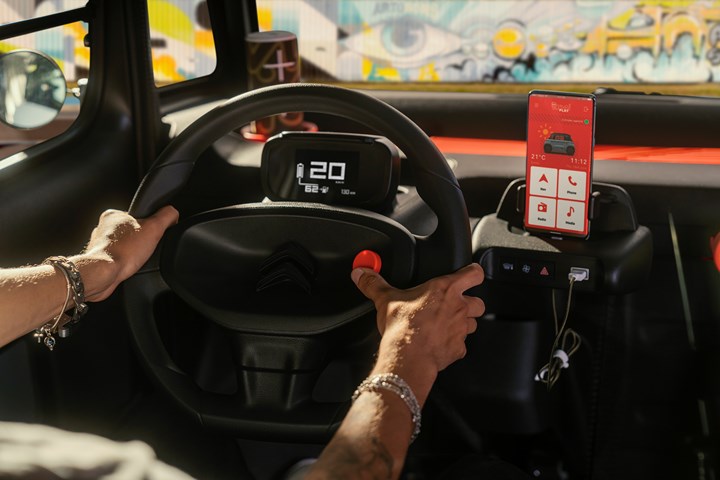
The smartphone as touchscreen and a Bluetooth-enabled orange button to control it. Perhaps simplicity is going to become the new black. (Image: Citroen)
The Citroën Ami is described by the company as a “non-conformist mobility object.”
It is a diminutive—2.41-m long; 1.39 m wide (sans mirrors); 1.52 m high—electric vehicle. It has a 5.5-kWh battery that powers a 6-kW motor.
The top speed is 28 mph. Its range is up to 46 miles.
Simply, an urban vehicle. For hipsters.
While new vehicles tend to have increasingly large touchscreens, the people at Citroën have taken a different approach.
One’s smartphone is the touchscreen.
A clamp fitted to the console has been designed to accommodate the phone.
The company has come up with another simple approach for the driver to access the “My Ami Play” system, which includes functions including access to navigation apps, calling, media, and radio.
The “Citroën Switch.”
It’s a large, Bluetooth-enabled orange button that is affixed to the steering wheel.
The button allows the driver to access My Ami Play while keeping eyes on the road.
Consider:
While this whole approach is certainly more fundamental than the more elaborate approaches that are becoming increasingly common as OEMs show they’ve got as much capability as tech companies (see previous item), isn’t it possible that this simpler execution has appeal, especially for people who are interested in things like the Ami?
To be sure, this quadricycle may simply be something of a phenomenon for the centers of cities like Paris or London, but as micromobility vehicles increase in deployment, simple approaches could be eminently viable.
>>>
August Sales Up YoY. But Then There’s a “But”. . .
The good news is that light vehicle sales in the U.S. in August were up 4% year-over-year, according to LMC Automotive.
But then there’s an asterisk.
- For one thing, there was an extra selling day compared with August 2021.
- For another, LMC notes that this 4% rise is on “a weak 2021 base.”
Directionally correct, but. . .
The total sales were approximately 1,130,000 vehicles, of which 972,000 were retail sales (up 1.2% YoY) and 158,000 were fleet (up 26.7% YoY).
So maybe this means that getting a rental will become somewhat easier.
Still. . .
Jeff Schuster, president, Americas Operations and Global Vehicle Forecasts, LMC: “The U.S. auto market is not expected to see much relief before the end of 2022 or into early 2023.”
Schuster added: “Capacity utilization is well below normal levels at 61%, though as supply of parts improves, we could see an initial overbuild until the market finds the true level of underlying demand.”
Maybe next year.
>>>
Meanwhile, in the UK. . .
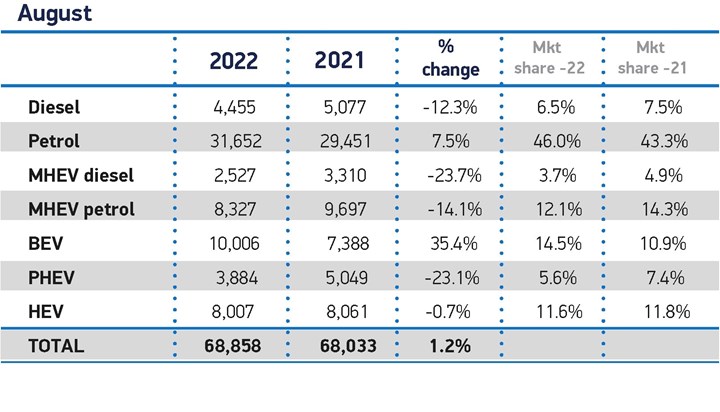
There’s plenty to unpack in those UK August sales numbers by powertrain type. Note how even the total diesel market share figure (diesel plus diesel mild hybrid) is lower than the number of hybrids alone (10.2% vs. 11.6%). (Image:SMMT)
There was also a rise in vehicle sales in the UK in August, an increase of 1.2% over August 2021. This is the first time in five months there was an arrow pointing up rather than down.
But. . .according to the Society of Motor Manufacturers and Traders (SMMT) it was the weakest August—putting 2021 aside—since 2013.
Still. . .
There was a segment that is really showing strength: battery electric vehicles.
BEV sales were up 35.4% in August, with only gasoline (a.k.a., petrol) the only type of powertrain being in positive territory (7.5% up YoY).
But. . .
While BEV sales were up, sales are slowing. SMMT says that at the end of Q1 2022 BEV sales were up by 101.9%.
Note to Liz Truss
Mike Hawes, SMMT chief executive: “Spiraling energy costs and inflation on top of sustained supply chain challenges are piling even more pressure on the automotive industry’s post-pandemic recovery, and we urgently need the new Prime Minister to tackle these challenges and restore confidence and sustainable growth.”
And Ms. Truss probably thought being foreign secretary was a tough gig.
>>>
Unintended Consequence of Fossil Fuel Replacement
“More than 80% of the sulfur used industrially comes from oil and natural gas, which typically contain 1–3 weight percent sulfur.”
“As the world decarbonises over the next three decades, the supplies of sulfur will drop, just when the material is needed most.”
Those comments are from a paper recently published in The Geographical Journal. (H/T: IEEE Spectrum)
The authors explain that when fossil fuels are desulfurized, the resulting sulfur (that 80%) is then used to produce sulfuric acid.
Why is that interesting?
Because sulfuric acid is used in the mining of metals and minerals including cobalt, nickel and neodymium, which are used for things like electric vehicle batteries and motors.
The authors write:
“Depending on how rapidly the world decarbonises and the amount of negative carbon emissions used to offset fossil fuel use, there could be a shortfall in sulfuric acid of between 100 and 320 million tonnes. That is a shortfall of between 40% and 130% of current production by 2040.”
Not all sulfur comes from refining fossil fuels. There is, the authors point out, an “almost limitless supply of elemental sulfur and sulfate minerals in evaporites, volcanic deposits, gypsum and anhydrite but new industries will be required to reduce sulfates to sulfur in order to exploit most of these resources.”
What’s more, there is apparently an issue regarding CO2 emissions in some of this processing.
And they write: “More immediately, the sulfur shortfall could be offset by expanding mining of sulfides and elemental sulfur, but at large environmental costs.”
Evidently, going “green” isn’t as straightforward of swapping out propulsion systems.
(Note: This isn’t just about transportation. Sulfur is a key ingredient in fertilizers. And by 2040 we’re going to need a lot more of that, too.)
>>>
Case of the Squeaking Teslas
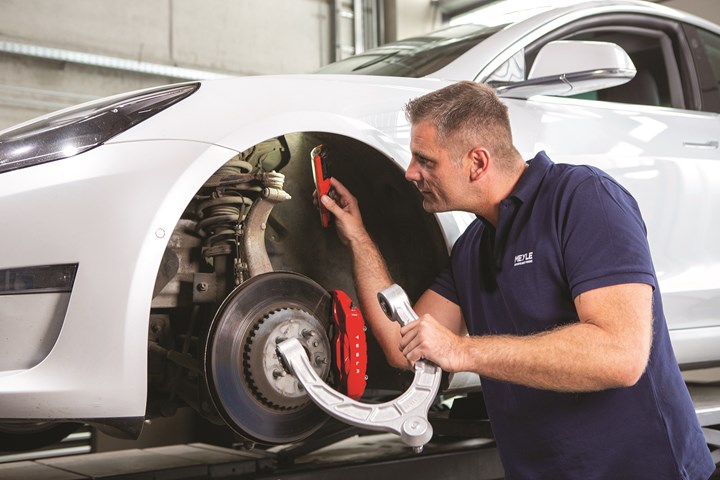
Forged aluminum upper control arm to replace OE Tesla arms in Model Y and Model 3 models that squeak. (Image: MEYLE)
Although it would seem that Tesla has plenty of problems on its hands related to software-based systems (e.g., Autopilot), turns out that there are some less complicated issues related to the Model Y and Model 3 that are vexing vehicle owners.
“Many everyday objects can begin to squeak after a certain period of time. But we weren’t expecting this to happen with the Tesla.”--Stefan Bachmann, Head of Steering & Suspension Product Team, MEYLE.
Bachmann says there have been reports from around the world that there are squeaking sounds coming from the front axles of the vehicles.
Source of the Squeak
A development team from MEYLE, a German supplier of aftermarket components, ID’d the problem as emanating from the upper control arm.
They discovered that rain drains from the windshield down to the control arm, and penetrates the ball joint.
And that led to the squeaks.
The company developed a replacement control arm. It is made with high-strength, forged aluminum and the company says it is lighter than the original component, which is made from steel and plastic.
The design of the ball joint not only has a larger diameter, which helps distribute forces across a bigger surface, but crimping is not necessary for assembly, so water penetration is eliminated.
As are, presumably, squeaks.
>>>
What Do Drivers Want Next Time?
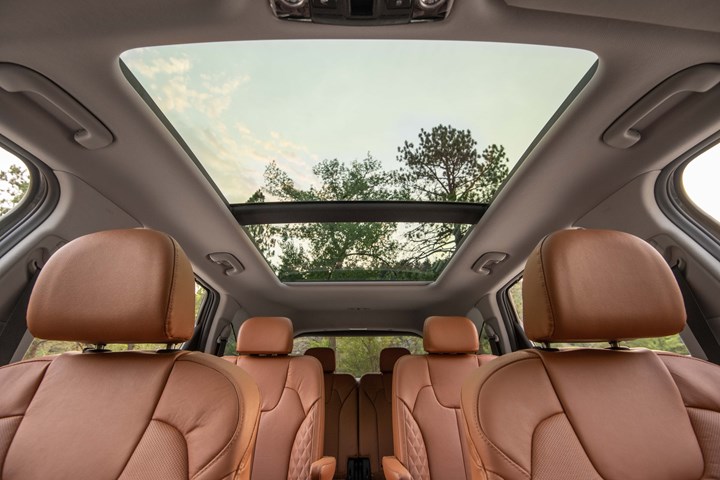
People really find sunroofs/moonroofs to be appealing. (Image: Kia)
One of the things that OEMs absolutely have to get right is offering features that people in the market for a vehicle want. Or will want. This is all the more important as there is a fairly general move to reduce build variations in order to address complexity.
AutoPacific has queried over 11,000 people who said they’re going to be in the market for a vehicle in the next three years: What are they looking for in their next vehicle?
The research firm offered a selection of more than 120 features and technologies as part of its Future Attribute Demand Study (FADS).
What is the #1 choice? Something along the lines of an advanced driver assistance system?
Nope.
A wireless charging pad for front seat occupants.
And prospective customers are willing to pay $50 to get it.
The second-most wanted feature is also not something that is new, advanced technology.
Rather, a sunroof/moonroof.
Although that feature has improved over the years from being a rectangular slot in the sheet metal over the front seats to something that essentially serves as the roof of even a full-size SUV, it is a hardly a new technology, with roots going back 100 years.
It isn’t until #5 on the FADS top 10 that something of a “high-tech” nature: front and rear parking sensors.
One could argue that #4, dash camera, would qualify, but it seems that something you can pickup aftermarket on Amazon isn’t quite as advanced.
However. . .
As another part of FADS there is an examination of the differences between those buying conventional ICE vehicles and electrified when it comes to tech.
Ed Kim, AutoPacific president and chief analyst: “Alternative powertrain intenders have historically been on the cutting edge of technology and are typically more open to, and demanding of, advanced technologies.”
And the data proves it. For example, while 21% of ICE vehicle intenders are interested in electronic noise cancelation systems, 37% of EV intenders express interest (and one could argue that it would be of greater benefit to the first group, rather than the second). Across the board—from 110-V outlets to eco-friendly materials—the ICE intenders are less interested.
One curious thing is that plug-in hybrid intenders are more interested in forward automatic emergency braking than EV intenders, 50% to 47%.
All of which is to say that product planners have quite a challenge figuring out what to put in where and what to leave out.
>>>
2023 Kia Sportage X-Pro Prestige AWD
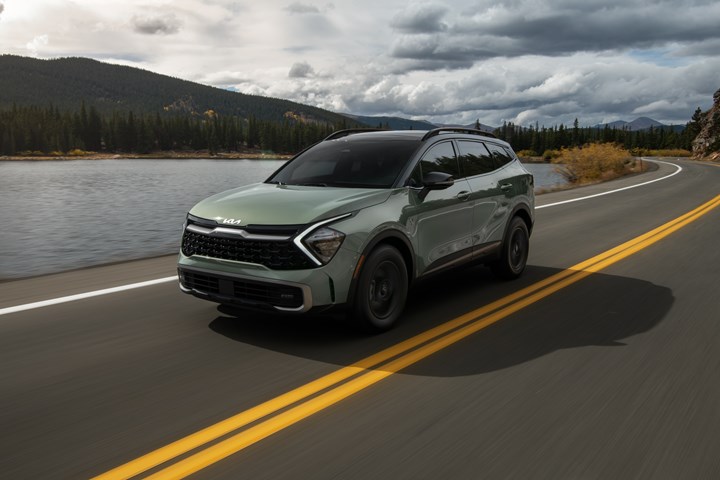
Yes, it is capable of driving on surfaces that are unsurfaced. But there is something to be said for asphalt. (Image: Kia)
A few years ago I sat in conference rooms and listened to Kia execs describe the company as being a “challenger brand.”
They were talking about a company that once had a string of cringe-worthy vehicles on offer. One of the saving graces was that there weren’t all that many sold and therefore the vehicles were somewhat under the proverbial radar.
Still, when one thought about Kia back then it was more about a low sticker price than a high expectation in any metric. When it came to some of those models, if you got something that was “cheap and cheerful” the “cheerful” part was an absolute bonus.
The company could have continued on that path, which would have probably led it to Oblivion.
Or the company could have decided to up its offerings a bit and try to gain some traction with a showroom of mediocre products with good financing to move the sheet metal.
Or it could have done something really hard: To transform itself into a company that makes vehicles that are both well-executed and desirable.
Which is what Kia has done. And, based on its performance in the past two J.D. Power Vehicle Dependability Studies— taking #1—the vehicles that it has on the market are solid, to boot.)
An excellent example is the 2023 Sportage X-Pro Prestige AWD.
While I will soon be writing about the 2023 Kia EV6, an electric vehicle that people in certain offices in Detroit, Germany and Japan are scratching their heads about, wondering how Kia did that, in one regard I consider this small SUV more of an accomplishment because the competition in that space is so widespread and aggressive and this one is really well executed. (That is: the EV space is still comparatively sparse; the Sportage space is packed.)
Bigger. Of course.
This is an all-new generation for the Sportage.
It is bigger than the previous generation.
It is 183.5 inches long, 73.4 inches wide, 66.3 inches high (AWD w/roof rails) and has a 108.5-ibnch wheelbase. The respective numbers for the previous generation are 176.4, 73, 64.8 and 105.1.
Based on that, as you might imagine it is roomier, offering 168-cu. ft. of passenger room and 39.5-cu. ft. of cargo room. Both capacities are said, by Kia, to be best-in-class (the class contains things including the Honda CR-V and the Toyota RAV4, so it is a smart class).
It has a 187-hp, 178 lb-ft of torque 2.5-liter engine. It is mated to an eight-speed automatic. Because this is meant to be an off-road(ish) vehicle (thus the “X” in its nomenclature), there is a locking center differential, which is more serious than some competitive AWD setups.
The ground clearance is 8.3 inches, an important metric for those who actually do drive where the pavement ends. Just out of curiosity to see how that number stacks up, the Honda CR-V is 8.2, so a tenth difference. (Not that anyone would necessarily do a comparison, the Jeep Cherokee is 8.7 inches.)
Serious screen(s)
The other key word in the title of the vehicle is “Prestige,” and this is where the Sportage absolutely astounds, if only for one thing (although there are more points of interest in its favor). There are two screens, both 12.3 inches, one for the operative gauges (speedometer, tach, fuel, etc.), one for the infotainment (navigation, iTunes, Spotify, etc.). The screens are seamlessly integrated such that it appears to be a single curved surface, 24.6 inches across.
While there are wider screens out there (e.q., the Cadillac LYRIQ has one that’s 33 inches), I’ve yet to be in a vehicle that stickers under $40K (this one has a base MSRP of $36,790; add in a few options, including the Jungle Green body and Black roof paint, and destination, and it came in at $38,665) that has a more impressive user interface.
There is a long list of standard driver-assist tech, from forward collision avoidance assistance to smart cruise control with stop-and-go capacity. The Prestige trim adds in things like LED lamps fore and aft and a blind-spot view monitor.
In terms of styling, if we go back in time to Kias of An Earlier Age, it seemed as though some of those exterior designs were mailed in—and they forgot the stamp.
That is far from the case here. Clearly the design team wanted to make sure that the Sportage stands out among the aforementioned legion of competitors. I do think, however, that the front end execution, particularly for the X-Pro Prestige, is a little busy, with plenty of shapes, textures, forms, lighting all coming together in a somewhat jarring manner.
I think today with vehicles like this the challenge has been met.
Kia is no longer a challenger brand. Others need to compete with it.
>>>
ADAS Terms to Know (5)
Here is a continuation of the series of nomenclature defined by AAA, Consumer Reports, J.D. Power, National Safety Council, PAVE, and SAE International to make things more understandable regarding autonomous tech:
DRIVER MONITORING
Indirect Driver Monitoring System Observes vehicle states, motions and/or driver performance indicators to estimate driver distraction, inattention, or misuse. This may include monitoring steering wheel input, vehicle sway within the lane, or a combination of other factors monitored by the vehicle systems. Some systems may provide a warning to the driver and/or limit the use of other features.
Direct Driver Monitoring System Detects the driver’s eye and/or head movement to estimate where the driver is looking. Some systems may provide a warning to the driver and/or limit the use of other features.
Driver Re-engagement System A series of escalating warnings and interventions attempting to engage an unresponsive driver. If the driver does not respond, the system brings the vehicle to a full stop while maintaining steering control. Some systems may steer the vehicle to the side of the road and/or make an emergency call if the driver fails to respond.
>>>
Harbinger Develops a Medium-Duty EV Powertrain/Chassis
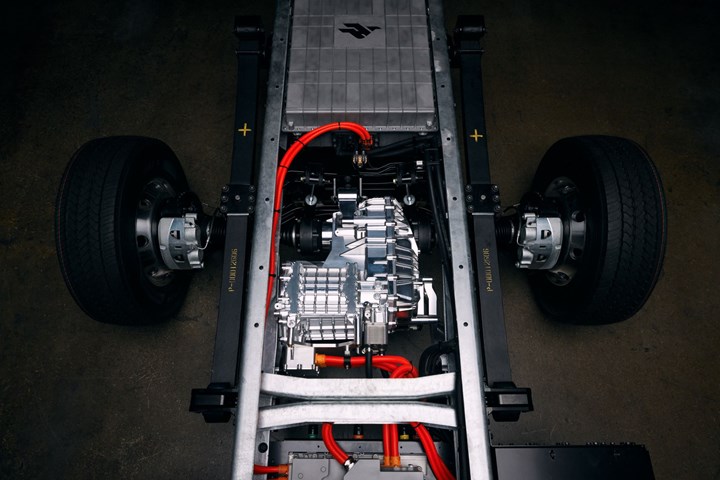
Harbinger engineers worked on an array of vehicle components, from the batteries to the propulsion unit. (Image: Jack Schroeder)
One of the consequences of the pandemic is that commercial vehicles have become all the more essential—and if you’re a vehicle developer, interesting.
This has led to the creation of new companies to supply vehicles in the Class 4 to Class 7 space (i.e., GVWRs between 14,001 and 33,000 pounds, or there abouts).
Companies that are developing platforms predicated on electric drives, not combustion.
Like Harbinger, a startup out of LA that is introducing a electric vehicle platform for medium-duty trucks.
The debut will be at next week’s North American International Auto Show in Detroit.
For Fleets
“Medium-duty vehicles serve as the backbone of the commercial transportation industry and are responsible for delivering tens of millions of packages and critical services every day
“But while this industry has experienced tremendous growth, fleet customers today face acute shortages of gas- and diesel-powered vehicles, and any meaningful supply of production-ready EV offerings is still years out. We are solving this problem head on.”-- John Harris, CEO of Harbinger
Cost-Effective
While one could quibble about the availability comment (let’s face it: the availability of all types of vehicles is troubling at the moment, but there are volume EV trucks out there: Ford reported that through August it had sales of 3,938 E-Transits, but it is also worth noting that according to Ford it has >90% of the segment, so certainty at the moment the segment is comparatively small), Harbinger has a compelling argument for its medium-duty offering:
“Our technology was developed from scratch in order to control top level chassis cost,” Harris says, and goes on, “The cost effectiveness of the platform is a baseline, not a sacrifice.
“Our platform will offer an enhanced level of efficiency, durability, safety, and performance over our competition and can be sold at a better price point because of our advantages of in-house component design and vertically integrated approach. This is how EVs should be built.”
The company says there will be “zero-acquisition premium” compared with diesel- or gasoline-powered trucks.
Elements
The core of the vehicle is an eAxle combining the motor, inverter and gearbox.
There is a liquid-cooled 800-V battery system that is scalable in 35-kWh increments. There is one-hour DC fast-charging capability.
The platform is said to be applicable for both last-mile delivery (<100 miles per day) and RVs (>100 miles per day).
Harbinger intends to have trucks at customers in late ’23 and to go into volume production in 2024.
RELATED CONTENT
-
On Traffic Jams, Vehicle Size, Building EVs and more
From building electric vehicles—and training to do so—to considering traffic and its implication on drivers and vehicle size—there are plenty of considerations for people and their utilization of technology in the industry.
-
On Military Trucks, Euro Car Sales, Mazda Drops and More
Did you know Mack is making military dump trucks from commercial vehicles or that Ford tied with Daimler in Euro vehicle sales or the Mazda6 is soon to be a thing of the past or Alexa can be more readily integrated or about Honda’s new EV strategy? All that and more are found here.
-
On the Genesis GV80, Acura MDX, BMW iDrive and more
From Genesis to Lamborghini, from Bosch to Acura: new automotive developments.


.jpg;width=70;height=70;mode=crop)






